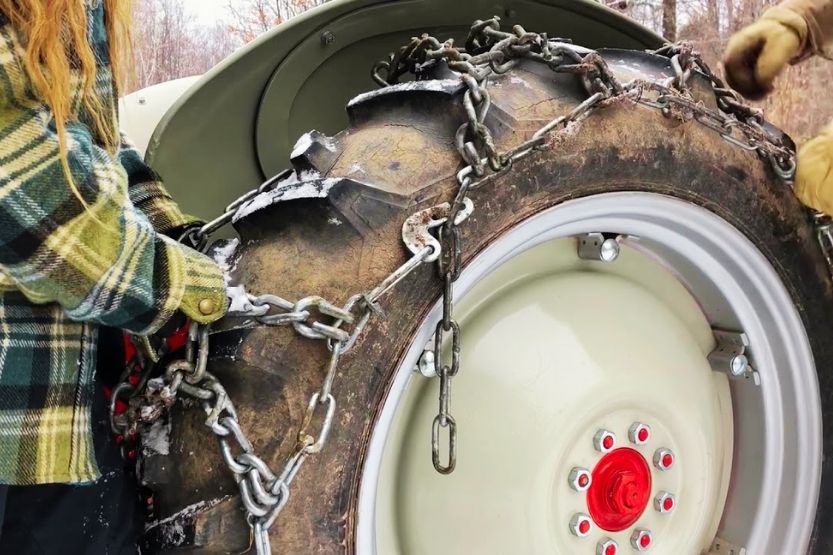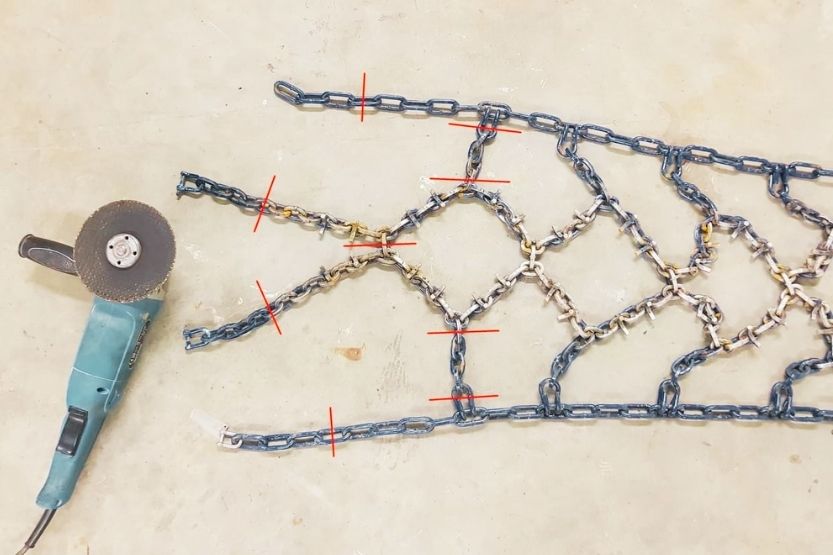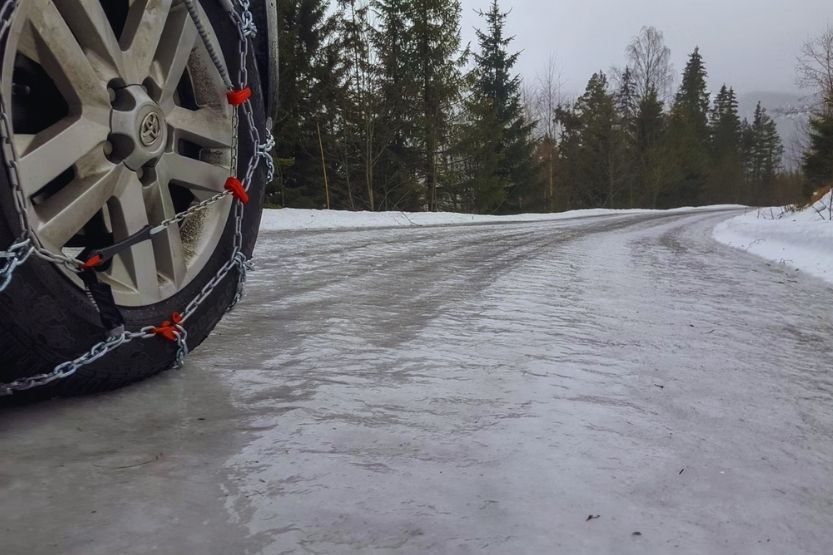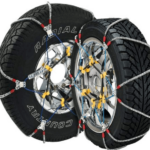Are you transferring to an area where you will be required to drive on roads with lots of snow? There’s a high risk of going on snow-covered roads. You need to know how to put chains on tires to ensure your safety.
Installing and removing tire chains may be a bit daunting if it’s the first time you are doing it. It’s rather simple, though. First, you need the right type of tire chains for the size and make of your tires. You need to fit one chain for each tire. After installing the chains, drive your car forward slowly, and then stop and tighten the tire chains.
It can be challenging to put tire chains on your tires if the weather is already bad. Installing them on your tires will be a lot easier before you hit the snowy roads. Tire chains will also make your driving safer when traveling on mountainous terrain and steep roads.
Read on to learn more about tire chains, the steps of installing tire chains on your tires, and how to drive with tire chains on your tires.
How to Put Chains on Tires

Get Tire Chains That Fit the Size and Make of the Tires
You need to know how to put on tire chains, especially if you must drive on snowy roads often. Doing it may appear difficult, but it is a straightforward process. First, you need to get tire chains that will exactly fit the size and make of your tires.
Install and Tighten the Tire Chains
After installing them, drive your car slowly forward. And then stop and tighten the tire chains. You have to do this before you hit the snowy roads. This way, it will be easier than putting them on your tires when you are already in the middle of a snowy pavement.
Maintain Control of Vehicle
Driving on snowy roads with chains on your tires will ensure your safety. You will maintain control of your vehicle and ensure its safe handling.
You are running the risk of a road accident if you are driving on snowy roads without the proper chains on your tires. Tire chains can enhance your safety while driving on steep and mountainous roads.
Put Chains on Your Tires in 11 Easy Steps

As I have said, putting on tire chains on your tires seems to be difficult. That’s only an impression. If you know how to do it and keep doing the same procedure several times, you will see that it is not that difficult. So, here is the process of putting on tire chains on your tires:
1. Get Tire Chains that Match Your Tires
The first thing you need to do is check the sizes of your tires. It will determine the size of the tire chains that you will need. The specs of your tires are indicated along the outside edges of your tires. They are given by a long string of letters and numbers.
Here is how to interpret them:
- First Digit: Width of the tire.
- Second Digit:Tire height ratio which is the ratio of the tire sidewall height to the tire width.
- Third Digit: Represents the tire diameter, usually given in inches.
Armed with this information, you can now go to a shop that sells tire chains. Look at the package of the tire chains. The package will indicate the size of the tire that it will fit in. You should get tire chains with a package that indicates it is suited to the size of your tire.
2. Remove the Snow Chains from their Package
Open the package and remove the tire chains inside. Untangle their links. If there are kinks or twists, loosen them to hang in web shape form freely. This is not easy to do. Be patient, for it may take some time before you can untangle all the tire chains.
3. Lay the Tire Chains on the Ground
Lay the tire chains on the pavement next to their respective tires. If you have a front-wheel-drive vehicle, you need to install the snow chains on the two front wheels.
You should put the tire chains on the two rear wheels for rear-wheel-drive vehicles. But if you have a four-wheel-drive pickup, you should install tire chains on all four wheels.
If you are concerned about safety, you should install tire chains on all four tires, whether a front-wheel-drive or a rear-wheel-drive vehicle. That will give you enhanced control of your vehicle and improve its handling on snowy and icy roads.
Again, how to put chains on tires? Putting chains on tires might look difficult, but it is simple. First, get tire chains that fit your tires. Once installed, slowly drive your car forward, stop and make adjustments.
4. Fit the Tire Chain on Top of the Tire
Ensure that you have your car on the parking brake before you start fitting tire chains on your tires. Now, straighten the tire chain over the top of the tire lengthwise. Some of its parts will naturally hang down along the sides of the tire.
Make sure that about three-quarters of the tire chain is covering the tire. Also, make sure that the chain parts that run from side to side across the tire width are straight.
5. Tuck the Snow Chain
Now, tuck the chain between the tire bottom and the ground. This will hold the tire in place as you drive your car slowly forward.
There are tire chains that come with rings attached to the chain. These rings run along the inside of the wheel. They should rest at the tire bottom, close to the ground during the installation.
If you have this tire chain type, you have to go underneath your vehicle to install it. You may also need to adjust it a little to be straight on.
6. Drive Your Vehicle Forward Slowly

To install the part of the tire chain that is not yet fitted to the tire, you need to drive your vehicle forward slowly. So, disengage the parking brake make sure nobody or nothing is obstructing the front of your vehicle.
Start the engine, put it in first gear, step on the brakes and the clutch slightly, and slowly release the brakes. Your vehicle should move slightly forward. This will enable the rest of the tire chain to be exposed so you can fit in the remaining portion of it to the tire.
7. Turn the Wheel Toward the Inside of Your Car
If you have sensed that the wheel has moved enough to have full tire coverage for the tire chain, turn the wheel inwards of your car. This will give you easier access to the connections. You can then finish securing the rest of the tire chain to the tire:
- If you are putting on the tire chain on the right tire, you have to turn the steering wheel to the left so the right tire will be pointed inwards.
- If you are putting the snow chain on the left tire, you need to turn the steering wheel to the right so the left tire will be pointed inwards.
- Before installing the remaining portion of the tire chain, put your car in parking brake.
8. Connect the Chains Together
Now, you need to connect the chains to cover the remaining portion of the tire. Start from the inner part of the tire close to the axle. There are two hooked edges in the chain. Connect them.
After doing that, connect the edges on the outer part of the tire as well. Then rotate the tightening cam or closer link so that the chains are as snug as they can be on the tire.
Standard tire chains come with a link tightening tool that you can use for tightening the chains. But it’s not advisable to use them on chains with link units.
If the chain you bought has no built-in tightening cam, you should get a bungee cord with hook fasteners. You can use this cord to tighten the chains over your tire. They are available at stores that sell tire chains.
9. Ensure that the Inner and Outer Connections Are Aligned
Make sure that the chains are going straight across the entire tire width. If the inner part of the chain is already tight, but the outer part is still loose, adjust the chains on either side. This will help you straighten the chains. Once the chains are all straight, tighten them.
10. Repeat the Same Procedure for the Other Tires
You should at least put tire chains to two of your tires: one each for your front tires if you have a front-wheel-drive vehicle, or one each on your rear tires if you have a rear-wheel-drive vehicle.
If you have a 4×4 pickup, you should put tire chains on all four tires. You only need to repeat the same procedure as the first tire.
11. Go On a Test Drive
Once you are sure that all the tire chains are properly installed on your tires, you need to test if your installation is correct and adequate. Drive at least 100 feet forward. Stop and re-tighten the snow chains. As you drive your car forward, the tire chains will shift slightly.
So, you need to check if they are still tight enough. Check on them and use the tightening cam or closer link to correct the slack to ensure that they are. The point is: they should be tight and straight enough so that they can provide you the safety they are supposed to give as you drive on snowy roads.
About Snow Chains
In most areas in the United States, the winter season transforms roads into snowy, icy, and slippery pavements. These types of surfaces are treacherous. To safely travel these roads during winter, you must use tire chains on all your four tires.
Tire chains are designed to make your car handle snowy roads safer and better. They will give your car improved traction if installed on all four tires.
When a tire chain wraps around a tire, it enables the tire to bite more profound into the ice and snow. That prevents your car from spinning out easily while traversing snowy roads.
True, it will limit the speed of your car, but that’s a wise trade-off since you are dealing with roads that are unsafe to drive. It’s good to know how to put on tire chains so you will always be safe when the snow has fallen on the ground.
Conclusion: How to Put Chains on Tires
Putting chains on your tires and removing them can be quite difficult if it is your first time. It’s not as difficult as it seems, though. First, you need to have the correct tire chains for the size and make of your tires.
Put a tire chain on each of your tires. After you’ve done it on all four tires, you have to drive your car slowly forward. Then stop the car and tighten the tire chains before proceeding on your trip on snowy pavements.
Put the tire chains before you hit the snowy roads. It will be a lot easier this way than putting them while you are already in the middle of snowy and slippery pavements. Driving on snowy roads without chains on your tires is very risky.

![How to Read a Dipstick [Easy Steps and Tips] how to read a dipstick](https://roadsumo.com/wp-content/uploads/2022/01/how-to-read-a-dipstick-150x150.jpg)
![How to Use Fix-a-Flat [8 Easy Steps] how to use fix-a-flat](https://roadsumo.com/wp-content/uploads/2022/03/how-to-use-Fix-a-Flat-150x150.jpg)






